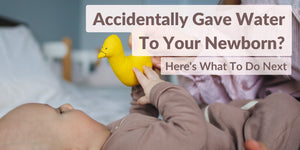Most babies are very excited about feeding themselves. Although you may be apprehensive about letting your little baby feed themselves, finger foods help your baby understand what foods look like as well as the associated taste and fragrance.
What Are Finger Foods For Baby?
Finger foods are small pieces of food that your baby can pick up and eat with their own hands, such as soft fruits and vegetables, soft cheeses, or cooked meat pieces. They encourage your baby to become more involved in the feeding process, as well as independent and develop self-feeding habits.
When Should You Start Finger Food For Baby
You're probably wondering when to start finger foods to your little one. Most nine-month-old babies are able to grip an object between their thumb and forefinger (the "pincer grip") to pick up small pieces of food and put them in their mouth. Around this time, babies begin to appreciate the variety of flavours and textures in food.
When babies learn to feed themselves, they become more self-reliant and establish healthy eating habits for life. Even small babies can tell when they've had enough food or are still hungry. Baby finger feeding gives them control over what they eat and helps them recognise when they're full and should stop eating.
Between the ages of 9 and 12 months, most babies are able to eat finger foods. You will know your baby is ready for finger foods if your baby does the following:
- Can hold the food items.
- Has sprouted some teeth.
- Seems more hungry in regular intervals.
- Is less interested in pureed foods and more interested in the food that adults are eating.
Best Finger Foods for Babies
Some of the best first finger foods for baby include:- Ripe bananas
- Small pieces of chicken or other meat, eggs, meatballs cut into smaller pieces, and ground meat or chicken
- Well-cooked pasta
- Well-cooked vegetables that can be mashed easily, such as carrots, beans, broccoli, and cauliflower
- Small pieces of roti, dosa, or parantha
- Cereals like bran flakes
- Muffins cut into small pieces
- Well-cooked beans such as kidney beans
- Soft foods like cheese, paneer, and tofu
- Fruits such as peach, papaya, mango, melon, kiwi, and soft pear
- Deboned pieces of fish
By 12 months, your baby will be able to have slightly firmer foods, such as:
- Raw vegetables, e.g., pieces of cucumber and carrots.
- Fruits, including strawberries, apricots, plums, cherries, and grapes.
- Pita bread with hummus or curd.
- Toasted bread, breadsticks.
How To Feed Finger Foods To Baby
Your baby may not be able to feed themselves adequately initially, so you can help by feeding them other foods, like cereal. Remember that your baby also needs the nutrients from breastmilk or formula in addition to finger foods, so do not discontinue breastfeeds or formula feeds.
Let your baby sit in a high chair at mealtimes and remain with them until they are done eating. You can choose to eat along with them. Your baby may make a mess at first, but they will eventually be able to feed themselves well.
Give food only when your baby is hungry, and offer small amounts at a time to avoid waste. Cut the foods into small, bite-sized pieces and, if you are offering fruits, peel them and remove any pits or seeds beforehand.
Do not be discouraged if baby finger feeding doesn't take on initially, and they refuse to eat a certain food. Most babies take time to adjust to new textures and flavours, so if they don't like something, present it to them again the following week. Some babies may have to try the food several times before they like it.
Choking and Gagging
Babies may choke or gag if they swallow a food item that is too large for them. Gagging is a natural reflex that prevents an object from getting stuck in the throat, and the child coughs or splutters as the food is pushed to the front of the mouth. Choking, on the other hand, is a silent condition and occurs when food gets stuck in the airpipe. Choking can be life-threatening and your baby requires immediate help in this situation.
To avoid choking or gagging, always supervise your child during mealtimes, avoid distractions such as cell phone or television use during mealtimes. When your baby is finger feeding avoid foods that can block their airway (e.g., nuts, hard candy, and whole grapes), and make sure to have your child sit down for meals.
Foods to avoid
- Whole cherry or grape tomatoes, berries or grapes
- Dried fruits, seeds, nuts, and peanuts
- Hard and raw fruit and vegetable pieces
- Whole hotdogs and sausages
- Popcorn, chips, and other snacks
- All types of candy and marshmallows
- Pieces of cheese or meat
- Untoasted or white bread
- Peanut/ Peanut butter
Now that you know what foods to introduce and avoid when your baby is finger feeding, make sure it is a fun experience for both your little one and you. Happy parenting!
References:
- KidsHealth. Finger foods for babies (2021).
- Infant and Toddler Forum. Finger foods (2021).
- Framingham State University. Baby foods to finger foods (2021).






LEAVE A COMMENT